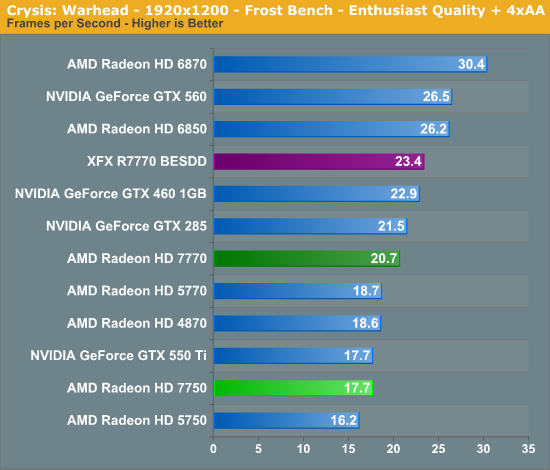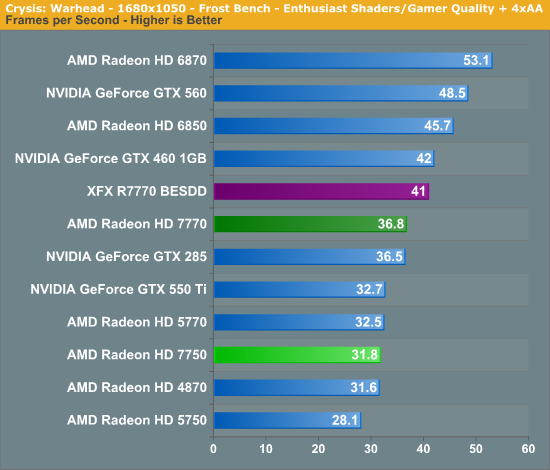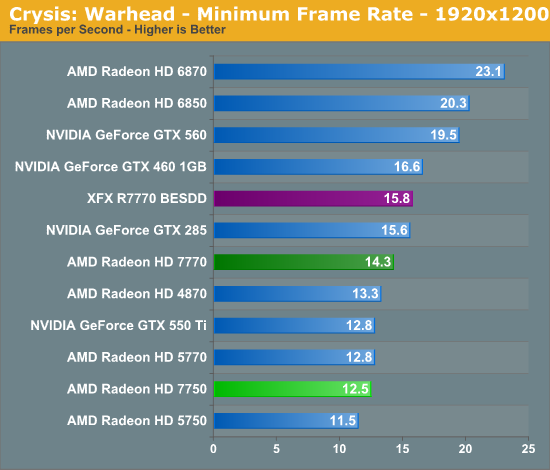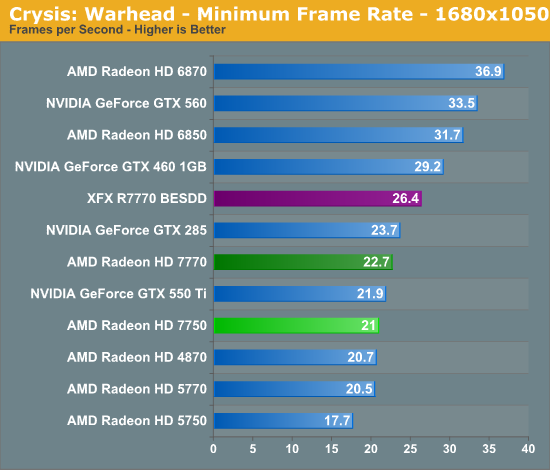AMD Radeon HD 7750 & Radeon HD 7770 GHz Edition Review: Evading The Price/Performance Curve
by Ryan Smith & Ganesh T S on February 15, 2012 12:01 AM EST- Posted in
- GPUs
- AMD
- HTPC
- GCN
- Radeon HD 7000
Crysis: Warhead
Kicking things off as always is Crysis: Warhead. It’s no longer the toughest game in our benchmark suite, but it’s still a technically complex game that has proven to be a very consistent benchmark. Thus even four years since the release of the original Crysis, “but can it run Crysis?” is still an important question, and the answer continues to be “no.” While we’re closer than ever, full Enthusiast settings at a 60fps is still beyond the grasp of a single-GPU card.


With AMD’s GCN architecture, Crysis is finally losing some of its predictive power, but it’s still a good indicator of overall performance. And the indicators aren’t very good.
From a price/performance perspective the 7700 needs to beat at least the 6850 on the AMD side and at least the GTX 560 on the NVIDIA side in order to ensure a clear-cut victory. Unfortunately it’s falling well short of that, underperforming the 6850 by 20% never mind the GTX 560. On paper the 7770 is outgunned on everything from texture performance to ROP performance to shader performance, so take your pick on what’s holding back Crysis performance, but the end result is that it’s well behind its previous-generation peers. In fact it’s closer to the 2.5 year old 5770 than it is the 6850.
As for the 7750, things are a bit better. In spite of its massive texture and shader deficit compared to the 7770, it’s only behind by 15%, offering some strong support that the actual performance difference between the two cards won’t be nearly as big as it is on paper. That said, on a price/performance basis it should be able to beat the 5770, and it isn’t quite there. But as the only card here that’s sub -75W, it has other favorable attributes.
Elsewhere XFX’s R7770 BESDD shows us that 7770 performance scales well with clockspeeds, with a 12% core overclock netting 11% better performance. This is a good sign for overclockers, but for factory overclocked cards it’s a mixed bag, as the higher price these cards fetch only puts them more in competition with the 6870.


The story of minimum framerates is much the same. The 7700 series continues to underperform its last-generation competition by quite a bit, and unfortunately we’re still several frames per second away from being able to sustain 30fps+ in Crysis at 1680.










155 Comments
View All Comments
KaDomoT - Wednesday, February 15, 2012 - link
Soemthing went very wrong during your Skyrim testing. I ran a 6870 in a similar rig (X4 955 @ 3.5ghz, 4gb ram, no ssd) @ 1920x1080 with 4x AA / 16x AF and A LOT of texture mods and my fps was MUCH higher than that. Not only that, but this was before the big performance boost in patch 1.4 / before I had even heard of SkyBoost!Admittedly my card was overclocked a good chunk (955 core / small mem oc) and my cpu had 600mhz on yours but no way that accounts for some massive 35+ fps difference especially when you guys have the performance patch and no mods.
takeship - Wednesday, February 15, 2012 - link
I think what everyone is missing here is that neither the 7750 or 7700 is really a card for builders, but for the OEM system builders, local shops, etc. For that segment, these cards are fastastic. Just look at the power and thermal loads - if you're HP, now you know you can sell the end customer a 7750 "HD Video" build for cheap, or a push the upgrade to 7770 based "HD Gaming" system without changing the power supply or cooling! That's huge for those guys. Simplification of the assembly line, part variety, etc etc. Same thing with Dad at home. Kid wants to play Battlefield? Buck at the shop around the corner knows that 7770 will get him there and then some playing on their "old" 1080p monitor without worrying that he'll see them back in 4 months when the system melts.CknSalad - Wednesday, February 15, 2012 - link
I think it's best to wait for kepler. There's really no point to be an early adopter of ati's 28nm cards. I'm sure the price will be fixed as the way it should comparable to nvidia's offerings. I just hope that nvidia is really taking the time to actually make quality gpus that are fairly mature. I wonder when there will be stable, legitimate drivers for ATI's 28nm cards. Hopefully that will give a decent boost in performance.haukionkannel - Wednesday, February 15, 2012 - link
Well this seems to be the trend. Older cards allways seems to better in bang for the buck department.It has been very slow time in GPU selling, so there are a lot of those old 5xx and 6xxx cards, so they have to sell those out before they can recure the prices for these new... Or nobody would buy those older allready produced cards. It is pity to us consumers, but a must to GPU manufacturers.
At this moment there is allmot none reason for AMD to make old 6xxx series cheaper, because the Nvidia is not making enough pressure. So they release new cards at extreme prices and sell those old card first.
Nogib - Wednesday, February 15, 2012 - link
I have been looking for an upgrade for my 4850 512MB card with a similar great bang for the buck that this card has given me all these years. Guess I'm still going to be looking. 7770 is close, but not enough of a leap to be honest. And while I'm sure the 78xx series will be great, I'm guessing it will be at a $250-$299 price range which is far beyond what I would ever consider spending on a video card. Sigh.Mathos - Wednesday, February 15, 2012 - link
You're right about the price/performance thing for a release.But, you also have to take some things into consideration. Some of the performance difference is likely due to the 6800 cards having a 256bit memory bus, as opposed to 128bit. Even with that standing I'm amazed the 7770 gets as close as it does. The main reason the 7770 is more expensive, I'm thinking is more likely so they can cease production on the 6800 series and dump inventory. The 68xx cards have been out for a while, and have benefited from many driver optimizations, but, you're not likely to see any more performance out of them from driver updates than what they already have. The 77xx cards are still based on a new core, which through driver updates will likely get much better performance over time.
Bottom line for me though, is, does it perform better than the 5770 that I currently have. Which, it does so considerably. More than could be said for the 6770. It also makes me wonder if they aren't gonna end up doing a 7790, basically a cut down pitcairn with a 256bit bus, like they did with the 6790.
chizow - Wednesday, February 15, 2012 - link
lol Hi rarson. :)Looks like you almost get it. Don't worry once the 7800 parts launch it'll fill in the blanks for you. The entire 7-series product stack pricing fails, top to bottom.
marc1000 - Wednesday, February 15, 2012 - link
actually the 7850 is the real star here. a board that does not require pci-e power and is able to almost match the 5770 in performance on most of the games. that was a 100w card.in the other hand, this makes me a little worried about the power requirements of 7800 series. i am hoping that both 7850 and 7870 will require only 1 pci-e power plug. my case is not big enough to handle more heat than that, and this is why i dont upgrade to a GTX560 (2x power connectors).
mczak - Thursday, February 16, 2012 - link
I think for the 7850 there is a possibility it would only have 1 power connector.The expectation is that Pitcairn is roughly "2xCape Verde", which means it should have roughly twice the power draw too. Twice the 7750 power draw is easily under 150W, whereas twice the 7770 power draw is not (well close actually according to measurements, but clearly these cards want to allow powertune +20% settings and overclocking).
That would be similar to HD6850/HD6870 where the 6850 only has one pcie power connector but the 6870 has two.
marc1000 - Thursday, February 16, 2012 - link
i meant 7750 is the star here.